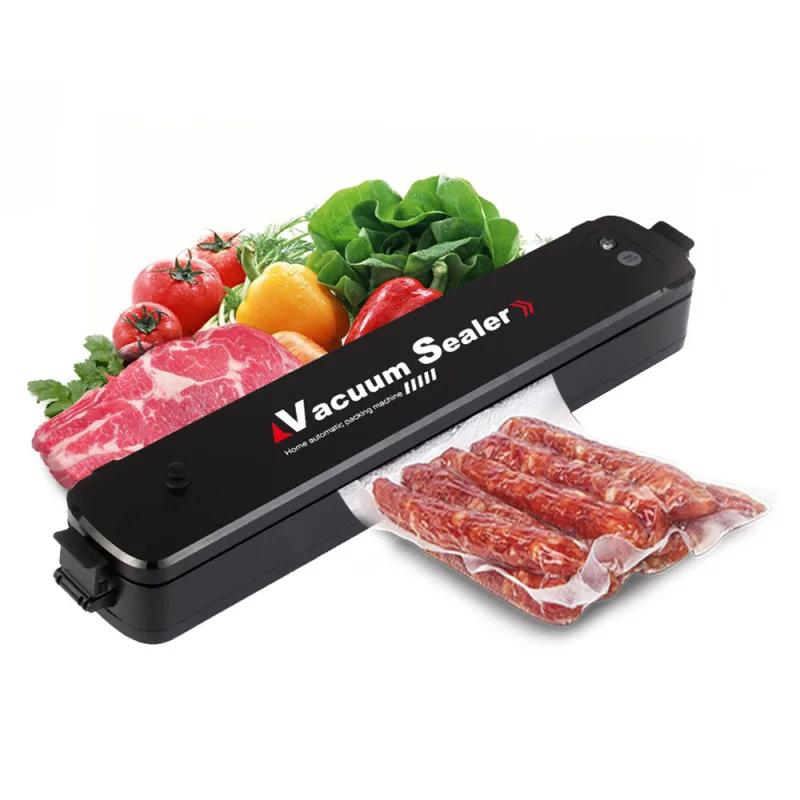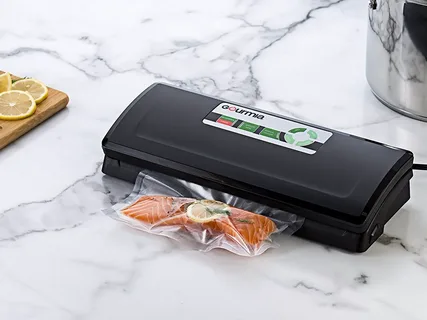Are you tired of throwing away freezer-burnt food? Say goodbye to that pesky issue with the innovative technology of a vacuum sealer. By using vacuum sealers, you can keep your food fresh longer, seal in flavour and nutrients, and prevent freezer burn. Explore the world of vacuum sealer technology and revolutionise the way you preserve your food.
Understanding the Science behind Vacuum Sealing
Vacuum sealing is a marvel of modern food preservation that hinges on a simple yet effective principle: eliminating air from food packaging. This process is instrumental in mitigating the proliferation of microorganisms such as bacteria, mould, and yeast, which are the primary culprits behind food spoilage. These microorganisms require oxygen to grow; thus, by extracting air and creating an anaerobic environment, vacuum sealing significantly slows down their development.
Removing oxygen has another beneficial effect; it curtails the oxidation process. Oxidation is a chemical reaction that affects food quality — it can lead to discolouration, off-flavours, and a reduction in nutritional value. For instance, foods rich in fats and oils are particularly prone to rancidity due to exposure to oxygen. Vacuum sealing, therefore, helps in preserving the aesthetic appeal, taste, and health benefits of food for longer periods.
Moreover, the vacuum sealing process is not limited to solid foods; with the appropriate techniques, it can also be extended to liquids and semi-solids, broadening its applicability in the kitchen. By understanding and harnessing the science behind vacuum sealing, individuals can significantly enhance the shelf life and quality of a wide array of food products, marking a departure from conventional preservation methods that are often less effective in combatting spoilage and nutrient loss.
The Benefits of Using a Vacuum Sealer Machine for Food Preservation
Using a vacuum sealer machine in food preservation offers an array of advantages that can significantly impact your wallet and well-being. Firstly, it drastically extends the shelf life of perishable goods, reducing the frequency of trips to the grocery store and cutting down on food wastage. Economically, this translates to substantial savings over time as bulk purchases become more feasible and less risky.
Additionally, by maintaining a near-perfect seal, these machines lock in freshness, taste, and nutritional value far better than traditional storage methods, ensuring meals are as healthy as they are delicious. This benefits daily food consumption and proves invaluable in preparing for long-term storage or emergency food supplies.
Moreover, the flexibility of vacuum sealers to accommodate a wide variety of food types—from solids to liquids—enhances their utility in the kitchen, making them indispensable tools for savvy food enthusiasts. The efficiency and practicality of vacuum sealing empower individuals to manage their food more thoughtfully and sustainably, aligning with modern trends towards responsible consumption and minimising environmental impact.
 Choosing the Right Vacuum Sealer for Your Kitchen
Choosing the Right Vacuum Sealer for Your Kitchen
Selecting an appropriate vacuum sealer requires careful deliberation on several key aspects to ensure it effectively meets your kitchen’s demands. Start by evaluating the volume of food you intend to preserve. Households that frequently store large quantities of food might benefit from a chamber vacuum sealer, known for its simultaneous efficiency in sealing multiple bags. Conversely, a handheld or external vacuum sealer could suffice for smaller quantities or occasional use, offering convenience and portability.
The variety of food you plan to seal also plays a crucial role in your decision-making process. If your culinary preferences lean towards sous-vide cooking or you often deal with liquids, opt for a model designed to handle such tasks easily. On the other hand, a basic model might meet your needs without the additional expense of straightforward dry food sealing.
Budget considerations are equally important. While chamber vacuum sealers offer robust features and durability, they come with a higher price tag. Handheld and external sealers, though more affordable, might lack some functionalities but still deliver significant benefits in food preservation.
Lastly, factor in the available space in your kitchen. Some sealers, especially chamber models, require more countertops or storage space. Assess your kitchen layout to choose a vacuum sealer that integrates well without causing clutter or inconvenience.
By considering these considerations, you can select a vacuum sealer that enhances your food preservation efforts and aligns with your kitchen’s operational flow and space constraints.
Vacuum Sealing Techniques for Different Types of Food
Mastering the art of vacuum sealing various types of food is crucial for maximising their shelf life and quality. For fragile items such as soft fruits or baked goods, the key is to utilise the gentle pulse feature available on many vacuum sealers. This allows for controlled air extraction, ensuring the food’s structure isn’t compromised. In contrast, robust items like hard cheeses and meats can be sealed at a standard setting.
When it comes to foods with sharp edges, such as dry pasta or certain cuts of meat with bones, a barrier should be placed between the food and the bag. This can be anything from greaseproof paper to a specifically designed mesh, preventing punctures that could compromise the vacuum seal.
Pre-freezing is a beneficial step for liquid-based foods or marinated meats. This solidifies the contents, preventing any liquid from being drawn out during sealing, which could otherwise interfere with the machine’s function and the bag’s seal. Once frozen, these items can be vacuum sealed in the usual manner.
Additionally, consider flash freezing on a tray before vacuum sealing for items used in portions, such as berries or nuts. This prevents them from clumping together, making removing exactly what you need easier without breaking the seal on the rest.
Implementing these specialised techniques ensures each food type is preserved at its best, extending freshness and maintaining quality.
Creative Uses of Food Vacuum Sealer beyond Food Preservation
The versatility of a food vacuum sealer stretches far beyond the confines of food preservation, opening up a world of creative possibilities. For the avid traveller, a vacuum sealer can be a godsend for compact packing. Clothing, for instance, can be vacuum sealed to reduce bulk in your suitcase, leaving more room for additional items or souvenirs. This technique also offers the benefit of protecting garments from moisture and odours.
Vacuum sealing can transform how you store seasonal items in the realm of home organization. From winter clothing to festive decorations, it provides an efficient and space-saving method to protect against dust, pests, and dampness, ensuring your belongings remain pristine.
Furthermore, important documents, photographs, and collectibles can be preserved through vacuum sealing. Removing the air and sealing these items away from environmental factors, you safeguard them against degradation over time. This method is particularly beneficial for items of sentimental value or critical importance, providing peace of mind that they are well protected.
Crafters and DIY enthusiasts will also find a vacuum sealer invaluable for organizing and preserving materials. Be it beads, patterns, or fabrics, vacuum sealing keeps your crafting supplies in order and minimises clutter, allowing for a more productive and enjoyable creative process.
Maintenance Tips for Vacuum Bag Sealer Machine
Ensuring your vacuum bag sealer machine remains in optimal condition is paramount for extending its lifespan and maintaining efficiency. Regular maintenance checks should include inspecting the sealing strip for any signs of wear or damage, as this could impact the quality of the seal and potentially lead to food spoilage. It’s crucial to keep the machine clean, paying particular attention to removing any food particles or residue that could accumulate in and around the sealing area, as this can interfere with the machine’s ability to vacuum and seal effectively.
Additionally, check the vacuum chamber and gaskets routinely. The gaskets, which provide an airtight seal during the vacuum process, can become stiff or cracked over time. Replacing them when necessary will ensure your machine continues to function correctly. If your vacuum sealer is a model that uses an oil pump, check the oil level regularly and top it up or change it according to the manufacturer’s guidelines.
Lastly, always follow the manufacturer’s instructions for use and care. This includes recommended storage practices when the machine is not in use. Adhering to these maintenance tips can help prevent malfunctions and ensure your vacuum bag sealer machine serves you well for many years.
Common Mistakes to Avoid When Vacuum Sealing
To harness the full potential of vacuum sealing, sidestepping certain pitfalls is crucial. A frequent oversight involves overstuffing the vacuum bag. This not only hampers the sealing efficiency but also increases the risk of incomplete sealing, exposing your food to air and spoilage. Another common blunder is selecting an inappropriate bag for the sealing task at hand. Not all bags are created equal, and using one that is incompatible with your vacuum sealer model can lead to a subpar seal or even damage to the device.
Moreover, ensuring a proper seal before initiating the vacuum process can compromise the integrity. It’s imperative to ascertain that the bag’s opening is correctly positioned within the sealing chamber and that no food residues obstruct the seal area. Adhering to these guidelines can improve your vacuum sealing results, preserving your food’s freshness and extending its shelf life effectively.
Conclusion
Vacuum sealer technology has dramatically transformed the approach towards food preservation, offering a robust solution to the age-old problem of maintaining food’s freshness and quality. This innovative method alleviates concerns over freezer burn and spoilage and ensures that the essence of the food—its flavour, nutritional value, and texture—is preserved for extended periods. As you navigate the options available, consider how a vacuum sealer can be tailored to your specific needs, considering the types of food you frequently store, the volume of food you handle, and your kitchen space. Embrace this technology to revolutionise how you store food and discover the myriad of possibilities it presents beyond traditional food preservation.
FAQs
Q: Is it possible to vacuum seal liquids, and how can I do it effectively?
A: Absolutely, liquids can be vacuum-sealed for preservation. The best method is to pre-freeze your liquids. Once solid, you can place them into a vacuum bag and seal them. This approach prevents any spillage during the vacuum process and ensures a perfect seal.
Q: For how long will food remain fresh if vacuum sealed?
A: The longevity of vacuum-sealed food greatly surpasses that of food stored using conventional methods. Generally, vacuum-sealed goods can remain fresh for 3 to 5 times longer. The exact duration depends on the food type and storage conditions.
Q: Are vacuum bags reusable, and what precautions should I take?
A: Yes, with proper care, vacuum bags can be reused. Wash them thoroughly after each use and inspect for any punctures or degradation that might impair the sealing capability. Ensure they are completely dry before reusing them to prevent bacterial growth and maintain an optimal seal.
| Other Good Articles to Read |
| Blogs Rain |
| Cme Blog Spot |
| Garcias Blogs |
| Yyc Blogs |
| Guiade Blogs |
| Blogs-Hunt |
| Impact-Blog |
| Smarty Blogs |
| Ed Blog |
| Mo Blogs |
| Blogs Em |
| Blogs T |
| Related Business Listings |
| Contact Directory |
| Local Business Profiles |

